Recent Advances in Microfluidic Impedance Detection: Principle, Design and Applications
Abstract
1. Introduction
2. Theory of Microfluidic Impedance Analysis
2.1. Microchannel Flow Characterization
2.2. Cell Model
2.3. Cell Deformation Model
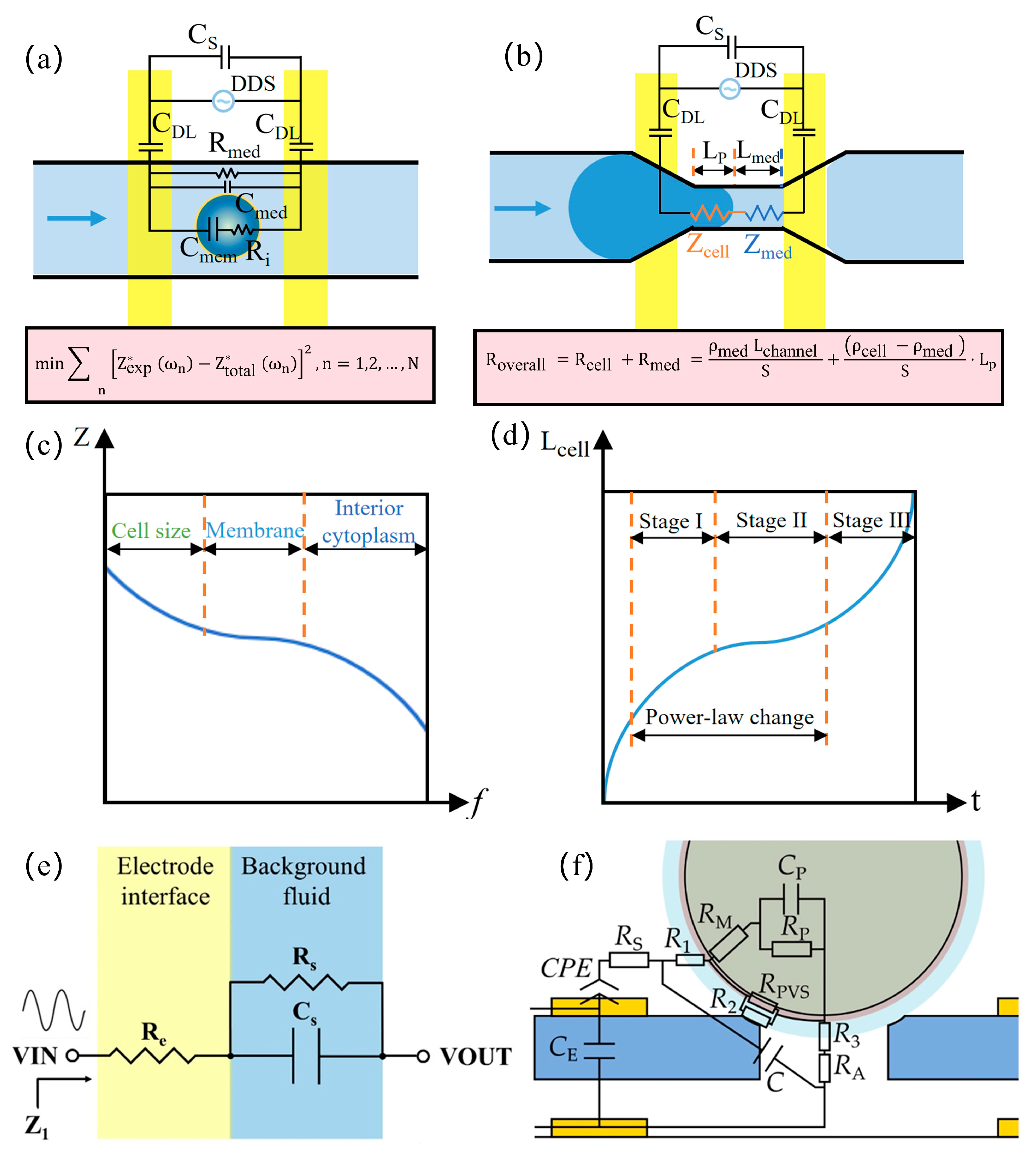
2.4. Microfluidic Impedance System Design
2.4.1. Static System Design—Electrical Impedance Spectroscopy (EIS)
2.4.2. Dynamic System Design—Impedance Flow Cytometry (IFC)
2.4.3. Electrode Design
3. Application of Microfluidic Impedance Analysis
3.1. Tumor Detection
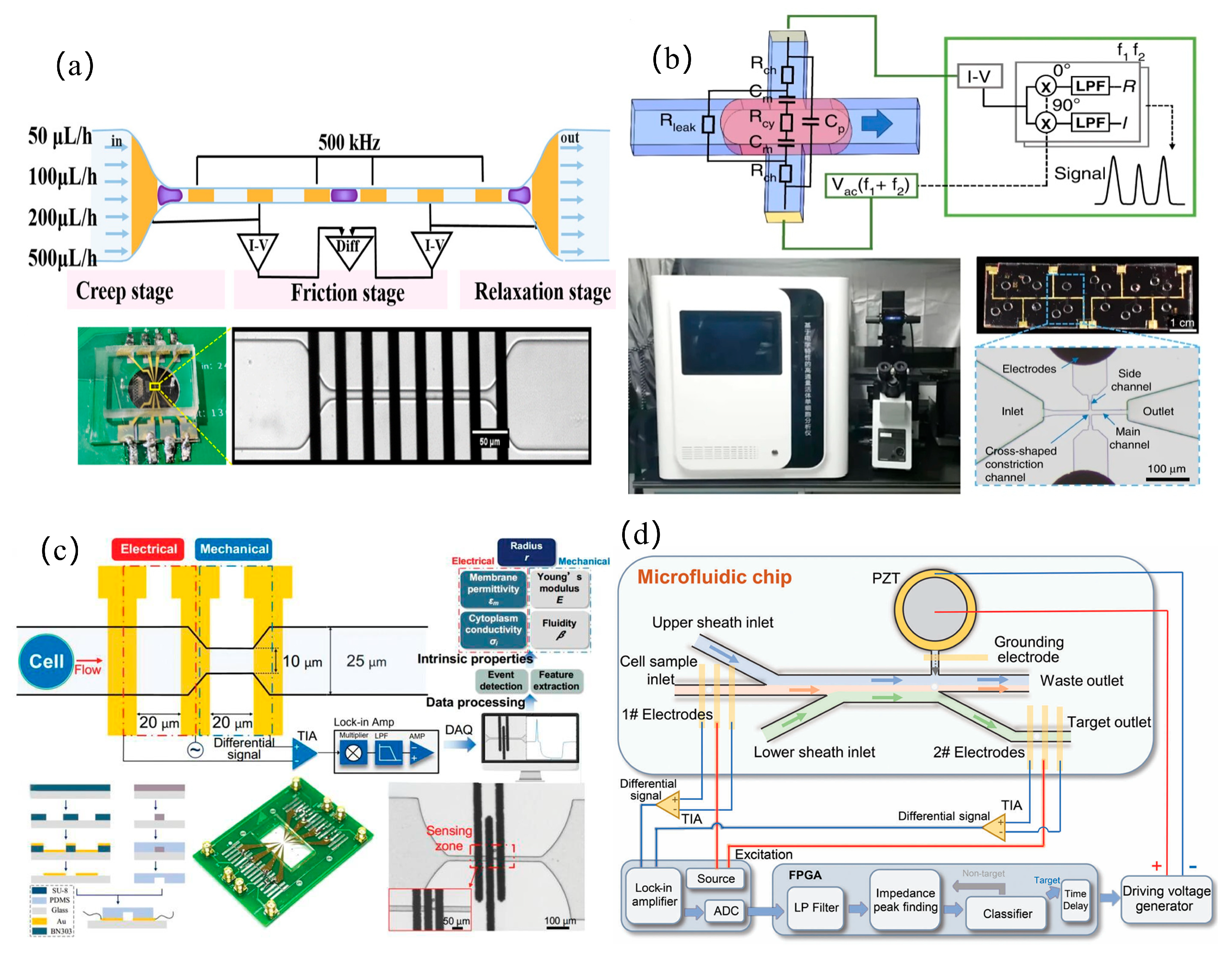
3.2. Blood Detection
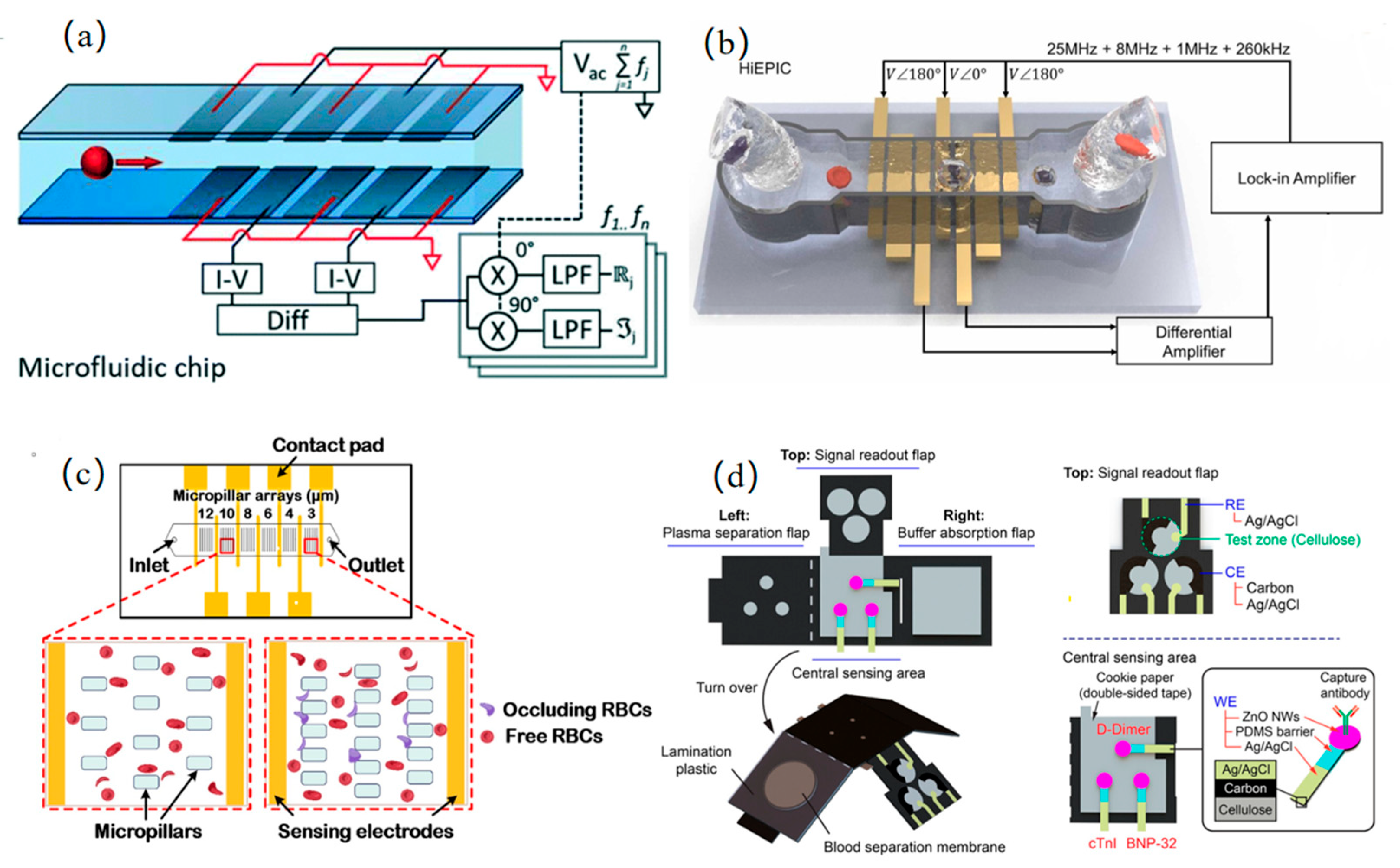
3.3. Organ on a Chip
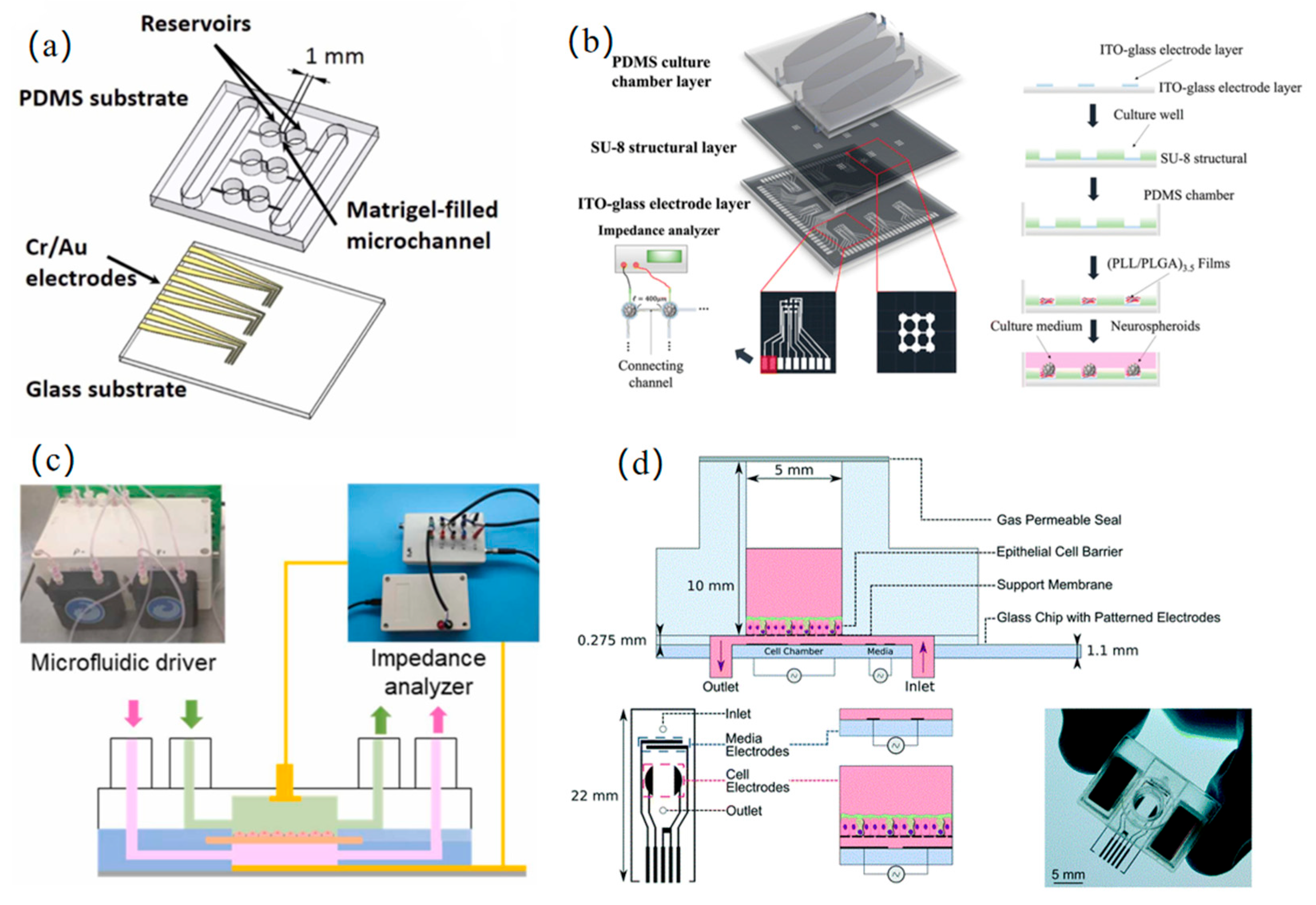
3.4. Microbial Detection
4. Conclusions and Outlook
- (1)
- Signal Noise and Interference Suppression: Signal noise represents a critical challenge affecting data accuracy and system reliability during microfluidic impedance measurements. Due to the compact size and high sensitivity of microfluidic devices, susceptibility to external electromagnetic interference exists, particularly in open measurement environments. Furthermore, device-intrinsic parasitic capacitance, poor contacts, and electrode contamination introduce additional noise, degrading signal quality. Differential measurement techniques are typically employed to effectively suppress common-mode noise through differential signal extraction for automatic noise balancing. Shielding materials and electromagnetic isolation methods, such as copper foil tapes, are utilized to minimize external interference. Signal processing approaches including filtering algorithms and adaptive noise cancelation algorithms have been implemented for post-processing raw signals to enhance signal quality and stability. Although numerous studies attempt to model and analyze impedance data using statistical methods and machine learning techniques, limitations persist in generalization capabilities and practical applicability due to insufficient data volume and sample imbalance. Particularly, machine learning algorithms require extensive annotated datasets for training, which are often unavailable in real-world scenarios.
- (2)
- Device Miniaturization and Standardization: While microfluidic technology inherently offers miniaturization advantages, achieving further size reduction becomes complex when integrating multi-channel, multi-parametric detection systems. Conventional microfluidic systems typically rely on single electrode arrays for impedance measurements, whereas practical applications necessitate integrated multiple electrodes and intricate microchannel designs to accommodate diverse detection needs. The miniaturization of impedance analyzers remains challenging, impeding portable system development. Additionally, standardization deficiencies exist since most microfluidic chips are laboratory-customized via photolithography without uniform specifications for electrode dimensions/materials. This variability hinders standardized performance evaluation across methodologies.
- (3)
- Biological Sample Pre-processing: Microfluidic impedance technology has significant applications in biomedical detection, particularly for the rapid analysis of biological samples like blood and urine. However, the inherent heterogeneity of biological samples, including cell density, protein concentration, and ionic strength, directly affects impedance measurements. Sample pre-processing is crucial in practice. For instance, whole blood contains abundant cellular components and solutes; direct measurement may cause signal confusion due to conductivity differences between cell membranes and solutions. Accuracy enhancement often requires pre-processing steps such as dilution, centrifugation, or filtration. Consequently, designing integrated pre-processing zones (e.g., filtration/separation units) within microfluidic chips is essential.
- (1)
- Standardization and manufacturing simplification must be prioritized: Unified chip design specifications (the electrode layout and channel dimensions) and detection protocols should be established to facilitate laboratory-to-industry translation. Cost-effective microfabrication techniques (e.g., lithography injection molding scale production) and novel electrode materials (flexible conductive polymers, carbon-based composites) require development to reduce precious metal dependency while improving batch consistency and mechanical stability.
- (2)
- Anti-interference capability and portability require targeted improvements: Integrated pretreatment modules (e.g., embedded filtration membranes) should be optimized to minimize matrix interference in complex samples (whole blood and saliva). Miniaturized signal processing units combined with low-power circuits must evolve toward handheld/wearable formats to meet POCT demands. Bioresorbable material innovations enabling implantable monitoring devices demand breakthroughs in long-term signal drift correction and biosafety evaluation through fundamental studies on material-biological interface dynamics.
- (3)
- Artificial intelligence (AI) systems and data processing strategies: AI and machine learning (ML) are increasingly being used in the data analysis and processing of microfluidic impedance chip systems [72,73,74]: Convolutional Neural Networks (CNNs) automatically extract spatial features (e.g., cellular morphology, impedance distribution), where local patterns are captured through convolutional layers while dimensionality reduction and noise resistance are achieved via pooling layers. Raw images/signals are directly processed to identify cell-type differences, and multi-source parameters (temperature/pH) are fused to enable real-time sensor drift correction. Recurrent neural network variants (GRU/LSTM) model temporal dynamics (e.g., impedance changes during cell division, biomarker fluctuations in sweat) through gating mechanisms, with long-term dependencies captured to predict physiological trends. These are combined with CNNs to form hybrid architectures (CNN-GRU) for spatiotemporal feature co-analysis. These methods further enhance the ability of impedance signals to predict cell behavior and response, accurately predict future dynamic changes in cells through real-time and historical data and greatly enhance the diagnostic performance of microfluidic impedance analysis technology. In addition, AI algorithms can also be used to control microfluidic impedance systems, form intelligent feedback mechanisms, adjust experimental conditions (such as the flow rate, measurement frequency, etc.) in real time, perform high-precision measurements of biological samples of different sizes and types, and achieve closed-loop control and adaptive adjustment. Furthermore, the AI method of integrating impedance analysis with multimodal data fusion such as optical imaging, biosensors, and Raman spectroscopy analysis is expected to further improve the sensitivity and specificity of microfluidic chips in diagnosis and detection.
- (4)
- AI-driven impedance microfluidic chip design: With the development of AI intelligent design microfluidic chips, as well as artificial intelligence expert models based on large language models such as ChatGPT [73,75], the development of impedance microfluidic technology chip design AI and expert models will become the key to the next generation of impedance microfluidic technology. This will greatly lower the threshold for the application of impedance microfluidic chips and make the technology accessible to a wider range of biological research fields.
- (5)
- Multimodal integration: Synergistic combinations with acoustic, magnetoelastic, and Raman spectroscopic techniques should create complementary multidimensional sensing. Self-powered systems, surface functionalization, self-cleaning microstructures, and modular replaceable electrodes require integration to extend chip lifespan and reduce maintenance costs.
Supplementary Materials
Author Contributions
Funding
Acknowledgments
Conflicts of Interest
References
- Du, J.; Wu, S.; Niu, L.; Li, J.; Zhao, D.; Bai, Y. A Gold Nanoparticles-Assisted Multiplex PCR Assay for Simultaneous Detection of Salmonella typhimurium, Listeria monocytogenes and Escherichia coli O157:H7. Anal. Methods 2020, 12, 212–217. [Google Scholar] [CrossRef]
- Kumar, B.K.; Raghunath, P.; Devegowda, D.; Deekshit, V.K.; Venugopal, M.N.; Karunasagar, I.; Karunasagar, I. Development of Monoclonal Antibody Based Sandwich ELISA for the Rapid Detection of Pathogenic Vibrio Parahaemolyticus in Seafood. Int. J. Food Microbiol. 2011, 145, 244–249. [Google Scholar] [CrossRef] [PubMed]
- Eringen, A.C. Simple Microfluids. Int. J. Eng. Sci. 1964, 2, 205–217. [Google Scholar] [CrossRef]
- Terry, S.C.; Jerman, J.H.; Angell, J.B. A Gas Chromatographic Air Analyzer Fabricated on a Silicon Wafer. IEEE Trans. Electron Devices 1979, 26, 1880–1886. [Google Scholar] [CrossRef]
- Manz, A.; Graber, N.; Widmer, H.M. Miniaturized Total Chemical Analysis Systems: A Novel Concept for Chemical Sensing. Sens. Actuators B Chem. 1990, 1, 244–248. [Google Scholar] [CrossRef]
- Duffy, D.C.; McDonald, J.C.; Schueller, O.J.A.; Whitesides, G.M. Rapid Prototyping of Microfluidic Systems in Poly(Dimethylsiloxane). Anal. Chem. 1998, 70, 4974–4984. [Google Scholar] [CrossRef]
- Shen, Y.; Yalikun, Y.; Aishan, Y.; Tanaka, N.; Sato, A.; Tanaka, Y. Area Cooling Enables Thermal Positioning and Manipulation of Single Cells. Lab Chip 2020, 20, 3733–3743. [Google Scholar] [CrossRef]
- Shen, Y.; Yuan, Y.; Tang, T.; Ota, N.; Tanaka, N.; Hosokawa, Y.; Yalikun, Y.; Tanaka, Y. Continuous 3D Particles Manipulation Based on Cooling Thermal Convection. Sens. Actuators B Chem. 2022, 358, 131511. [Google Scholar] [CrossRef]
- Shen, Y.; Yalikun, Y.; Tanaka, Y. Recent Advances in Microfluidic Cell Sorting Systems. Sens. Actuators B Chem. 2019, 282, 268–281. [Google Scholar] [CrossRef]
- Shen, Y.; Chen, Z.; Zhang, Y.; Hou, X. Liquid Interfacial Tension Design of Building New Concept Materials. Matter 2023, 6, 2506–2508. [Google Scholar] [CrossRef]
- Kivelson, D.; Madden, P. Theory of Dielectric Relaxation. Mol. Phys. 1975, 30, 1749–1780. [Google Scholar] [CrossRef]
- Ayliffe, H.E.; Frazier, A.B.; Rabbitt, R.D. Electric Impedance Spectroscopy Using Microchannels with Integrated Metal Electrodes. J. Microelectromechanical Syst. 1999, 8, 50–57. [Google Scholar] [CrossRef]
- Tang, T.; Liu, X.; Kiya, R.; Shen, Y.; Yuan, Y.; Zhang, T.; Suzuki, K.; Tanaka, Y.; Li, M.; Hosokawa, Y.; et al. Microscopic Impedance Cytometry for Quantifying Single Cell Shape. Biosens. Bioelectron. 2021, 193, 113521. [Google Scholar] [CrossRef]
- Tang, T.; Liu, X.; Yuan, Y.; Kiya, R.; Shen, Y.; Zhang, T.; Suzuki, K.; Tanaka, Y.; Li, M.; Hosokawa, Y.; et al. Dual-Frequency Impedance Assays for Intracellular Components in Microalgal Cells. Lab Chip 2022, 22, 550–559. [Google Scholar] [CrossRef]
- Sun, T.; Green, N.G.; Gawad, S.; Morgan, H. Analytical Electric Field and Sensitivity Analysis for Two Microfluidic Impedance Cytometer Designs. IET Nanobiotechnol. 2007, 1, 69–79. [Google Scholar] [CrossRef]
- Chai, H.; Feng, Y.; Zhu, J.; Meng, X.; Liang, F.; Bai, J.; Wang, W. Evaluating the Accuracy of Impedance Flow Cytometry with Cell-Sized Liposomes. ACS Sens. 2023, 8, 2681–2690. [Google Scholar] [CrossRef] [PubMed]
- Chen, Z.; Zhu, Y.; Xu, D.; Alam, M.; Shui, L.; Chen, H. Cell Elasticity Measurement Using a Microfluidic Device with Real-Time Pressure Feedback. Lab Chip 2020, 20, 2343–2353. [Google Scholar] [CrossRef]
- Tsai, S.-L.; Wey, J.-J.; Lai, S.-C.; Huang, Y.-Y. A Novel Microfluidic Chip Based on an Impedance-Enhanced Electrochemical Immunoassay. Phys. Fluids 2025, 37, 011920. [Google Scholar] [CrossRef]
- Cao, Y.; Floehr, J.; Azarkh, D.; Schnakenberg, U. Microfluidic Aspiration-Assisted Electrical Impedance Spectroscopy System Is a Reliable Tool for the Characterization of Oocyte Hardening. Sens. Actuators B Chem. 2023, 380, 133316. [Google Scholar] [CrossRef]
- Eeckhoudt, R.V.D.; Christiaens, A.-S.; Ceyssens, F.; Vangalis, V.; Verstrepen, K.J.; Boon, N.; Tavernier, F.; Kraft, M.; Taurino, I. Full-Electric Microfluidic Platform to Capture, Analyze and Selectively Release Single Cells. Lab Chip 2023, 23, 4276–4286. [Google Scholar] [CrossRef] [PubMed]
- Li, S.-S.; Xue, C.-D.; Hu, S.-Y.; Li, Y.-J.; Chen, X.-M.; Zhao, Y.; Qin, K.-R. Long-Term Stable and Multifeature Microfluidic Impedance Flow Cytometry Based on a Constricted Channel for Single-Cell Mechanical Phenotyping. Anal. Chem. 2024, 96, 17754–17764. [Google Scholar] [CrossRef] [PubMed]
- Wang, M.; Zhang, J.; Chen, X.; Li, Y.; Huang, X.; Wang, J.; Li, Y.; Huo, X.; Chen, J. Microfluidic Impedance Flow Cytometer Leveraging Virtual Constriction Microchannel and Its Application in Leukocyte Differential. Microsyst. Nanoeng. 2024, 10, 192. [Google Scholar] [CrossRef] [PubMed]
- Kim, B.; Yao, W.; Rhie, J.W.; Chun, H. Microfluidic Potentiometric Cytometry for Size-Selective Micro Dispersion Analysis. BioChip J. 2022, 16, 471–479. [Google Scholar] [CrossRef]
- Fang, Q.; Feng, Y.; Zhu, J.; Huang, L.; Wang, W. Floating-Electrode-Enabled Impedance Cytometry for Single-Cell 3D Localization. Anal. Chem. 2023, 95, 6374–6382. [Google Scholar] [CrossRef]
- Zhong, J.; Tang, Q.; Liang, M.; Ai, Y. Accurate Profiling of Blood Components in Microliter with Position-Insensitive Coplanar Electrodes-Based Cytometry. Sens. Actuators B Chem. 2022, 367, 132068. [Google Scholar] [CrossRef]
- Feng, Y.; Huang, L.; Zhao, P.; Liang, F.; Wang, W. A Microfluidic Device Integrating Impedance Flow Cytometry and Electric Impedance Spectroscopy for High-Efficiency Single-Cell Electrical Property Measurement. Anal. Chem. 2019, 91, 15204–15212. [Google Scholar] [CrossRef] [PubMed]
- Wu, G.; Qiu, H.; Liu, X.; Luo, P.; Wu, Y.; Shen, Y. Nanomaterials-Based Fluorescent Assays for Pathogenic Bacteria in Food-Related Matrices. Trends Food Sci. Technol. 2023, 142, 104214. [Google Scholar] [CrossRef]
- Guo, Y.; Wang, R.; Wei, C.; Li, Y.; Fang, T.; Tao, T. Carbon Quantum Dots for Fluorescent Detection of Nitrite: A Review. Food Chem. 2023, 415, 135749. [Google Scholar] [CrossRef]
- Wang, Y.; Zhu, L.; Guo, P.; Zhang, Y.; Lan, X.; Xu, W. Research Progress of All-in-One PCR Tube Biosensors Based on Functional Modification and Intelligent Fabrication. Biosens. Bioelectron. 2024, 246, 115824. [Google Scholar] [CrossRef]
- Zhao, X.; Peng, H.; Hu, J.; Wang, L.; Zhang, F. Nanotechnology-Enabled PCR with Tunable Energy Dynamics. Jacs Au 2024, 4, 3370–3382. [Google Scholar] [CrossRef]
- Aly, N.S.; Kim, H.-S.; Marei, Y.M.; Elhamshary, A.S.; Bayoumi, I.R.; Omar, R.E.; Mohammed, D.A.; Miyoshi, S.-I.; Rashed, G.A. Diagnosis of Toxoplasmosis Using Surface Antigen Grade 1 Detection by ELISA, Nano-Gold ELISA, and PCR in Pregnant Women. Int. J. Nanomed. 2023, 18, 1335–1345. [Google Scholar] [CrossRef] [PubMed]
- Peng, P.; Liu, C.; Li, Z.; Xue, Z.; Mao, P.; Hu, J.; Xu, F.; Yao, C.; You, M. Emerging ELISA Derived Technologies for in Vitro Diagnostics. TrAC Trends Anal. Chem. 2022, 152, 116605. [Google Scholar] [CrossRef]
- Hu, T.; Wu, Z.; Sang, W.; Ding, B.; Chen, K.; Li, X.; Shen, Y.; Ni, Z. A Sensitive Electrochemical Platform Integrated with a 3D Graphene Aerogel for Point-of-Care Testing for Tumor Markers. J. Mater. Chem. B 2022, 10, 6928–6938. [Google Scholar] [CrossRef]
- Zhu, J.; Feng, Y.; Chai, H.; Liang, F.; Cheng, Z.; Wang, W. Performance-Enhanced Clogging-Free Viscous Sheath Constriction Impedance Flow Cytometry. Lab Chip 2023, 23, 2531–2539. [Google Scholar] [CrossRef] [PubMed]
- Luan, X.; Liu, P.; Huang, D.; Zhao, H.; Li, Y.; Sun, S.; Zhang, W.; Zhang, L.; Li, M.; Zhi, T.; et al. piRT-IFC: Physics-Informed Real-Time Impedance Flow Cytometry for the Characterization of Cellular Intrinsic Electrical Properties. Microsyst. Nanoeng. 2023, 9, 77. [Google Scholar] [CrossRef]
- Feng, Y.; Zhu, J.; Chai, H.; He, W.; Huang, L.; Wang, W. Impedance-Based Multimodal Electrical-Mechanical Intrinsic Flow Cytometry. Small 2023, 19, 2303416. [Google Scholar] [CrossRef]
- Tang, D.; Jiang, L.; Xiang, N.; Ni, Z. Discrimination of Tumor Cell Type Based on Cytometric Detection of Dielectric Properties. Talanta 2022, 246, 123524. [Google Scholar] [CrossRef]
- Zhu, S.; Zhu, Z.; Ni, C.; Zhou, Z.; Chen, Y.; Tang, D.; Guo, K.; Yang, S.; Liu, K.; Ni, Z.; et al. Liquid Biopsy Instrument for Ultra-Fast and Label-Free Detection of Circulating Tumor Cells. Research 2024, 7, 0431. [Google Scholar] [CrossRef] [PubMed]
- Xie, X.; Zhao, J.; Liu, T.; Li, L.; Qin, Y.; Song, X.; Ge, Y.; Zhao, J. Label-Free and Real-Time Impedance Sensor Integrated Liver Chip for Toxicity Assessment: Mechanism and Application. Sens. Actuators B Chem. 2023, 393, 134282. [Google Scholar] [CrossRef]
- Zhu, J.; Pan, S.; Chai, H.; Zhao, P.; Feng, Y.; Cheng, Z.; Zhang, S.; Wang, W. Microfluidic Impedance Cytometry Enabled One-Step Sample Preparation for Efficient Single-Cell Mass Spectrometry. Small 2024, 20, 2310700. [Google Scholar] [CrossRef]
- Caselli, F.; Reale, R.; De Ninno, A.; Spencer, D.; Morgan, H.; Bisegna, P. Deciphering Impedance Cytometry Signals with Neural Networks. Lab Chip 2022, 22, 1714–1722. [Google Scholar] [CrossRef] [PubMed]
- Zhbanov, A.; Lee, Y.S.; Son, M.; Kim, B.J.; Yang, S. Improved Hematology Analysis Based on Microfluidic Impedance Spectroscopy: Erythrocyte Orientation and Anisotropic Dielectric Properties of Flowing Blood. Anal. Chem. 2025, 97, 4871–4880. [Google Scholar] [CrossRef] [PubMed]
- Huang, L.; Jasim, I.; Alkorjia, O.; Agca, C.; Oksman, A.; Agca, Y.; Goldberg, D.E.; Benson, J.D.; Almasri, M. An Impedance Based Microfluidic Sensor for Evaluation of Individual Red Blood Cell Solute Permeability. Anal. Chim. Acta 2023, 1267, 341226. [Google Scholar] [CrossRef] [PubMed]
- Oshabaheebwa, S.; Delianides, C.A.; Patwardhan, A.A.; Evans, E.N.; Sekyonda, Z.; Bode, A.; Apio, F.M.; Mutuluuza, C.K.; Sheehan, V.A.; Suster, M.A.; et al. A Miniaturized Wash-Free Microfluidic Assay for Electrical Impedance-Based Assessment of Red Blood Cell-Mediated Microvascular Occlusion. Biosens. Bioelectron. 2024, 258, 116352. [Google Scholar] [CrossRef]
- Fu, H.; Qin, Z.; Li, X.; Pan, Y.; Xu, H.; Pan, P.; Song, P.; Liu, X. Paper-Based All-in-One Origami Nanobiosensor for Point-of-Care Detection of Cardiac Protein Markers in Whole Blood. ACS Sens. 2023, 8, 3574–3584. [Google Scholar] [CrossRef]
- Sayad, A.; Uddin, S.M.; Yao, S.; Wilson, H.; Chan, J.; Zhao, H.; Donnan, G.; Davis, S.; Skafidas, E.; Yan, B.; et al. A Magnetoimpedance Biosensor Microfluidic Platform for Detection of Glial Fibrillary Acidic Protein in Blood for Acute Stroke Classification. Biosens. Bioelectron. 2022, 211, 114410. [Google Scholar] [CrossRef]
- Petchakup, C.; Chen, Y.Y.C.; Tay, H.M.; Ong, H.B.; Hon, P.Y.; De, P.P.; Yeo, T.W.; Li, K.H.H.; Vasoo, S.; Hou, H.W. Rapid Screening of Urinary Tract Infection Using Microfluidic Inertial-Impedance Cytometry. ACS Sens. 2023, 8, 3136–3145. [Google Scholar] [CrossRef]
- Na, J.-T.; Chun-Dong, X.; Wang, Y.-X.; Li, Y.-J.; Wang, Y.; Liu, B.; Qin, K.-R. Fabricating a Multi-Component Microfluidic System for Exercise-Induced Endothelial Cell Mechanobiology Guided by Hemodynamic Similarity. Talanta 2023, 253, 123933. [Google Scholar] [CrossRef]
- Huang, C.-H.; Lei, K.F. Quantitative Study of Tumor Angiogenesis in Three-Dimensional Matrigel Barrier Using Electric Impedance Measurement Technique. Sens. Actuators B Chem. 2022, 370, 132458. [Google Scholar] [CrossRef]
- Liang, C.-C.; Chen, P.-Y.; Liu, N.-C.; Lee, I.-C. Comparison between Dynamic versus Static Models and Real-Time Monitoring of Neuronal Dysfunction in an Amyloid-β Induced Neuronal Toxic Model on a Chip Platform. Lab Chip 2024, 24, 1887–1902. [Google Scholar] [CrossRef]
- Ceccarelli, M.C.; Lefevre, M.C.; Marino, A.; Pignatelli, F.; Krukiewicz, K.; Battaglini, M.; Ciofani, G. Real-Time Monitoring of a 3D Blood–Brain Barrier Model Maturation and Integrity with a Sensorized Microfluidic Device. Lab Chip 2024, 24, 5085–5100. [Google Scholar] [CrossRef] [PubMed]
- Dhwaj, A.; Roy, N.; Jaiswar, A.; Prabhakar, A.; Verma, D. 3D-Printed Impedance Micropump for Continuous Perfusion of the Sample and Nutrient Medium Integrated with a Liver-On-Chip Prototype. ACS Omega 2022, 7, 40900–40910. [Google Scholar] [CrossRef] [PubMed]
- Liang, F.; Huang, X.; Huang, B.; He, Y.; Luo, H.; Shi, J.; Wang, L.; Aimé, C.; Peng, J.; Chen, Y. A Microfluidic Tool for Real-Time Impedance Monitoring of in Vitro Renal Tubular Epithelial Cell Barrier. Sens. Actuators B Chem. 2023, 392, 134077. [Google Scholar] [CrossRef]
- Fernandes, J.; Karra, N.; Bowring, J.; Reale, R.; James, J.; Blume, C.; Pell, T.J.; Rowan, W.C.; Davies, D.E.; Swindle, E.J.; et al. Real-Time Monitoring of Epithelial Barrier Function by Impedance Spectroscopy in a Microfluidic Platform. Lab Chip 2022, 22, 2041–2054. [Google Scholar] [CrossRef] [PubMed]
- Khalid, M.A.U.; Kim, K.H.; Salih, A.R.C.; Hyun, K.; Park, S.H.; Kang, B.; Soomro, A.M.; Ali, M.; Jun, Y.; Huh, D.; et al. High Performance Inkjet Printed Embedded Electrochemical Sensors for Monitoring Hypoxia in a Gut Bilayer Microfluidic Chip. Lab Chip 2022, 22, 1764–1778. [Google Scholar] [CrossRef]
- Chen, X.; Shen, M.; Liu, S.; Wu, C.; Sun, L.; Song, Z.; Shi, J.; Yuan, Y.; Zhao, Y. Microfluidic Impedance Cytometry with Flat-End Cylindrical Electrodes for Accurate and Fast Analysis of Marine Microalgae. Lab Chip 2024, 24, 2058–2068. [Google Scholar] [CrossRef]
- Chen, J.; Zhong, J.; Lei, H.; Ai, Y. Label-Free Multidimensional Bacterial Characterization with an Ultrawide Detectable Concentration Range by Microfluidic Impedance Cytometry. Lab Chip 2023, 23, 5029–5038. [Google Scholar] [CrossRef]
- Muhsin, S.A.; Al-Amidie, M.; Shen, Z.; Mlaji, Z.; Liu, J.; Abdullah, A.; El-Dweik, M.; Zhang, S.; Almasri, M. A Microfluidic Biosensor for Rapid Simultaneous Detection of Waterborne Pathogens. Biosens. Bioelectron. 2022, 203, 113993. [Google Scholar] [CrossRef]
- Chen, J.; Zhong, J.; Chang, Y.; Zhou, Y.; Koo, S.H.; Tan, T.Y.; Lei, H.; Ai, Y. Rapid and Accurate Antimicrobial Susceptibility Testing Using Label-Free Electrical Impedance-Based Microfluidic Platform. Small 2024, 20, 2303352. [Google Scholar] [CrossRef]
- Tang, T.; Liu, X.; Yuan, Y.; Zhang, T.; Kiya, R.; Yang, Y.; Yamazaki, Y.; Kamikubo, H.; Tanaka, Y.; Li, M.; et al. Parallel Impedance Cytometry for Real-Time Screening of Bacterial Single Cells from Nano- to Microscale. ACS Sens. 2022, 7, 3700–3709. [Google Scholar] [CrossRef]
- Zhang, S.; Han, Z.; Qi, H.; Liu, S.; Liu, B.; Sun, C.; Feng, Z.; Sun, M.; Duan, X. Convolutional Neural Network-Driven Impedance Flow Cytometry for Accurate Bacterial Differentiation. Anal. Chem. 2024, 96, 4419–4429. [Google Scholar] [CrossRef] [PubMed]
- Piedimonte, P.; Sola, L.; Cretich, M.; Gori, A.; Chiari, M.; Marchisio, E.; Borga, P.; Bertacco, R.; Melloni, A.; Ferrari, G.; et al. Differential Impedance Sensing Platform for High Selectivity Antibody Detection down to Few Counts: A Case Study on Dengue Virus. Biosens. Bioelectron. 2022, 202, 113996. [Google Scholar] [CrossRef] [PubMed]
- Almalaysha, M.; Singh, A.; Muhsin, S.A.; Carlson, A.V.; Trout, K.E.; Morey, A.; Zhang, S.; Channaiah, L.H.; Almasri, M. A Highly Sensitive Microfluidic Biosensor for Rapid and Accurate Detection of Salmonella in Raw Chicken Products. Sens. Actuators Rep. 2025, 9, 100257. [Google Scholar] [CrossRef]
- Coatrini-Soares, A.; Coatrini-Soares, J.; Neto, M.P.; de Mello, S.S.; Pinto, D.D.S.C.; Carvalho, W.A.; Gilmore, M.S.; Piazzetta, M.H.O.; Gobbi, A.L.; Brandão, H.d.M.; et al. Microfluidic E-Tongue to Diagnose Bovine Mastitis with Milk Samples Using Machine Learning with Decision Tree Models. Chem. Eng. J. 2023, 451, 138523. [Google Scholar] [CrossRef]
- Dowdell, K.S.; Olsen, K.; Paz, E.F.M.; Sun, A.; Keown, J.; Lahr, R.; Steglitz, B.; Busch, A.; LiPuma, J.J.; Olson, T.; et al. Investigating the Suitability of Online Flow Cytometry for Monitoring Full-Scale Drinking Water Ozone System Disinfection Effectiveness. Water Res. 2024, 257, 121702. [Google Scholar] [CrossRef]
- Çam, S.B.; Çiftci, E.; Gürbüz, N.; Altun, B.; Korkusuz, P. Allogeneic Bone Marrow Mesenchymal Stem Cell-Derived Exosomes Alleviate Human Hypoxic AKI-on-a-Chip within a Tight Treatment Window. Stem Cell Res. Ther. 2024, 15, 105. [Google Scholar] [CrossRef]
- Wang, W.; Jin, Y.; Huang, Y.; Zhao, Z.; Li, M.; Mao, H.; Li, R.; Xiong, J. A Self-Driven Multifunctional Microfluidic Sweat Analysis System for Efficient Sweat Collection and Real-Time Monitoring. Sens. Actuators B Chem. 2024, 414, 135920. [Google Scholar] [CrossRef]
- Zahed, A.; Kim, D.K.; Jeong, S.H.; Reza, S.; Sharifuzzaman; Pradhan, G.B.; Song, H.; Asaduzzaman; Park, J.Y. Microfluidic-Integrated Multimodal Wearable Hybrid Patch for Wireless and Continuous Physiological Monitoring. ACS Sens. 2023, 8, 2960–2974. [Google Scholar] [CrossRef]
- Butement, J.T.; Wang, X.; Siracusa, F.; Miller, E.; Pabortsava, K.; Mowlem, M.; Spencer, D.; Morgan, H. Discrimination of Microplastics and Phytoplankton Using Impedance Cytometry. ACS Sens. 2024, 9, 5206–5213. [Google Scholar] [CrossRef]
- da Silva, T.A.; Juncá, M.A.C.; Braunger, M.L.; Riul, A., Jr.; Barbin, D.F. Application of a Microfluidic Electronic Tongue Based on Impedance Spectroscopy for Coconut Water Analysis. Food Res. Int. 2024, 187, 114353. [Google Scholar] [CrossRef]
- Xue, Y.; Hassan, Q.; Noroozifar, M.; Sullan, R.M.A.; Kerman, K. Microfluidic Flow Injection Analysis System for the Electrochemical Detection of Dopamine Using Diazonium-Grafted Copper Nanoparticles on Multi-Walled Carbon Nanotube-Modified Surfaces. Talanta 2024, 266, 125030. [Google Scholar] [CrossRef] [PubMed]
- Park, S.; Kim, S.; Lee, S.; Tsukruk, V.V.; Park, S.; Lim, H. Advanced Microfluidic-Based Wearable Electrochemical Sensors for Continuous Biochemical Monitoring. Adv. Electron. Mater. 2025, 85, 2500010. [Google Scholar] [CrossRef]
- Zhou, J.; Dong, J.; Hou, H.; Huang, L.; Li, J. High-Throughput Microfluidic Systems Accelerated by Artificial Intelligence for Biomedical Applications. Lab Chip 2024, 24, 1307–1326. [Google Scholar] [CrossRef] [PubMed]
- Liu, J.; Du, H.; Huang, L.; Xie, W.; Liu, K.; Zhang, X.; Chen, S.; Zhang, Y.; Li, D.; Pan, H. AI-Powered Microfluidics: Shaping the Future of Phenotypic Drug Discovery. ACS Appl. Mater. Interfaces 2024, 16, 38832–38851. [Google Scholar] [CrossRef]
- Nelson, M.D.; Goenner, B.L.; Gale, B.K. Utilizing ChatGPT to Assist CAD Design for Microfluidic Devices. Lab Chip 2023, 23, 3778–3784. [Google Scholar] [CrossRef]
- Page, M.J.; McKenzie, J.E.; Bossuyt, P.M.; Boutron, I.; Hoffmann, T.C.; Mulrow, C.D.; Shamseer, L.; Tetzlaff, J.M.; Akl, E.A.; Brennan, S.E.; et al. The PRISMA 2020 statement: An updated guideline for reporting systematic reviews. BMJ 2021, 372, n71. [Google Scholar] [CrossRef]
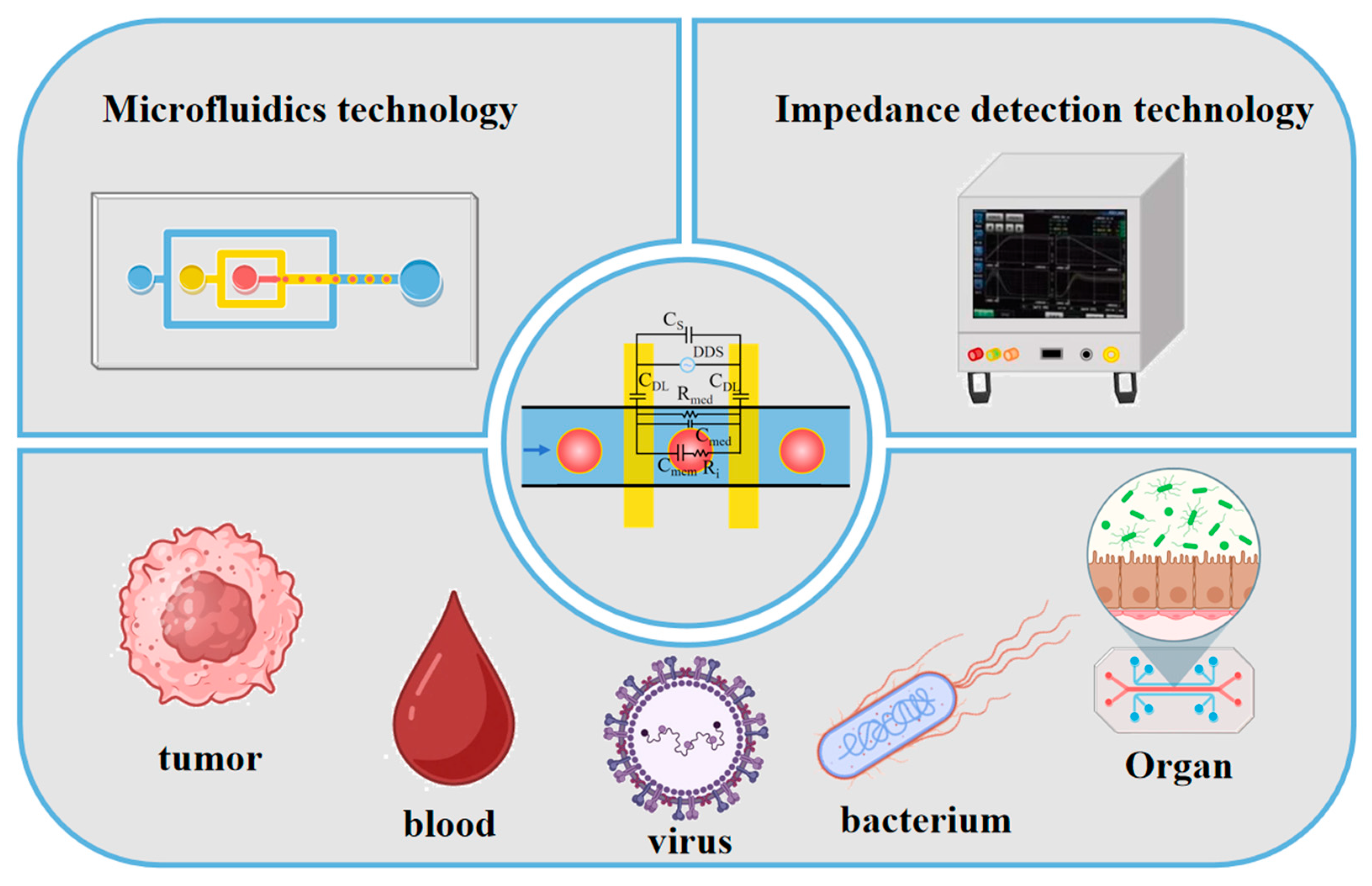
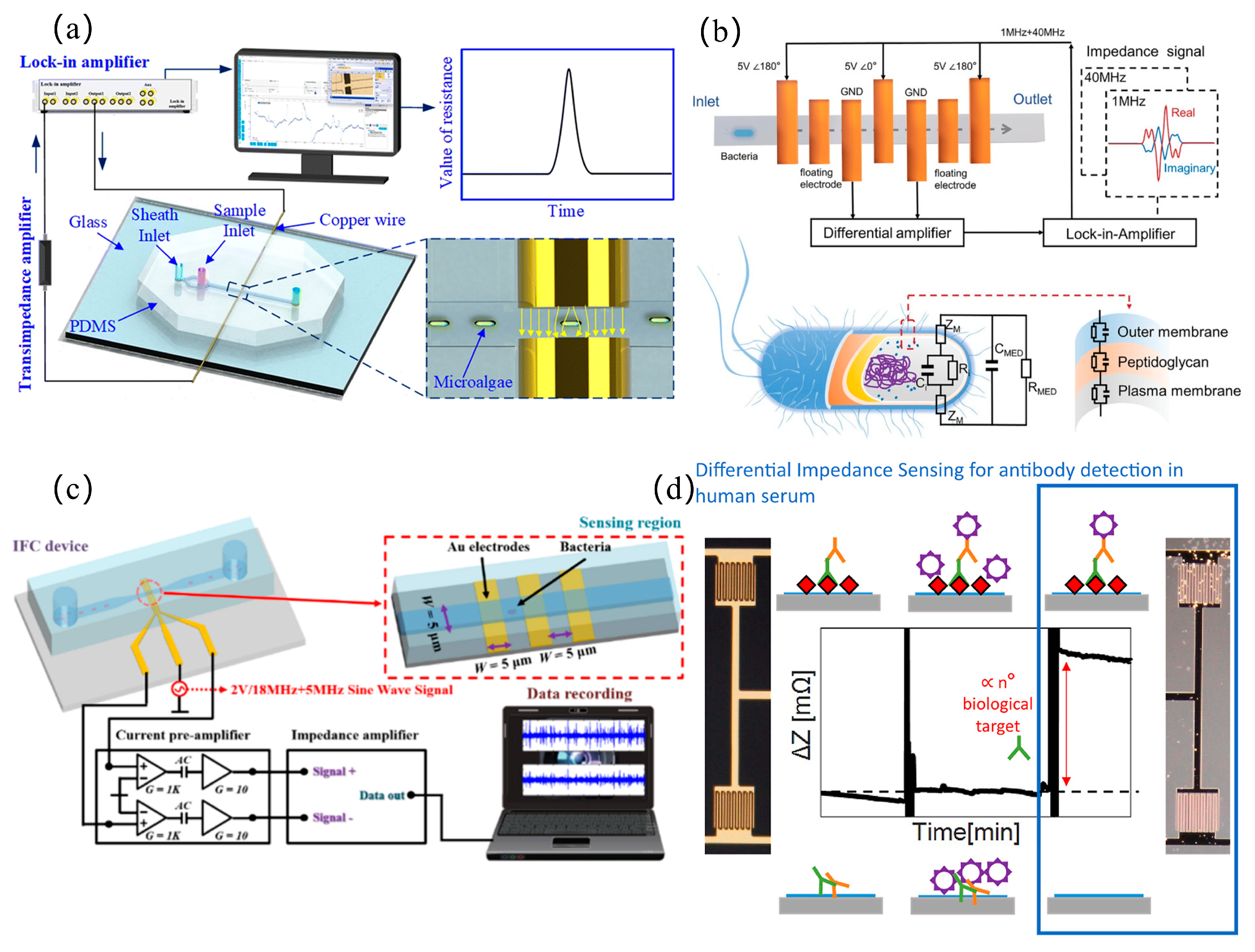
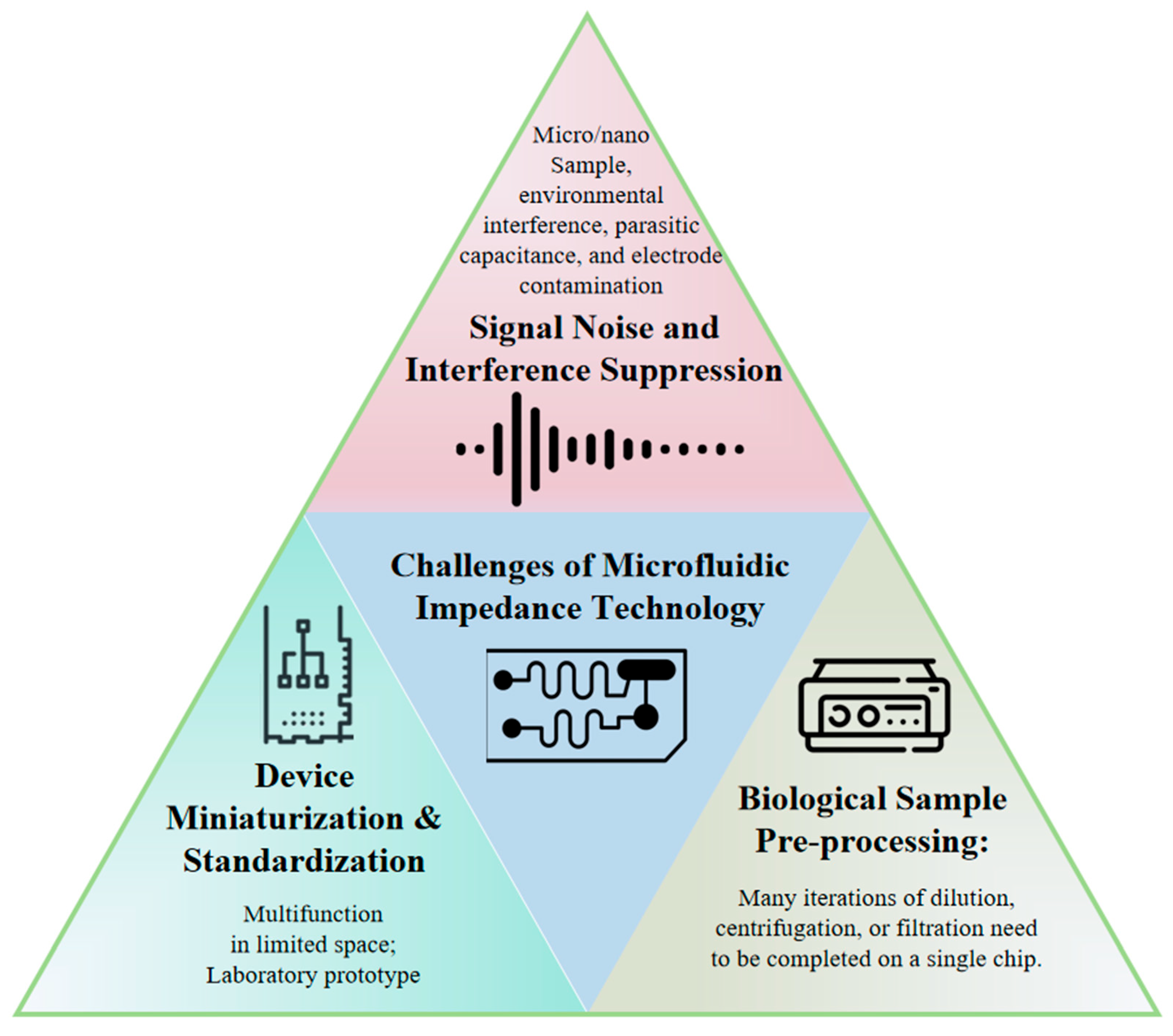
| Category | Microfluidic Impedance Detection | Fluorescence Detection [27,28] | PCR [29,30] | ELISA [31,32] |
|---|---|---|---|---|
| Principle | Label-free electrical detection based on dielectric property differences in cells/particles | Fluorescent dye labeling with optical signal acquisition | Nucleic acid amplification and fluorescence quantification | Antigen–antibody binding with enzymatic chromogenic reaction |
| Advantages | Label-free operation, real-time dynamic monitoring, miniaturized equipment, low sample consumption, simplified workflow | High sensitivity (single-molecule level), multi-channel parallel detection, mature technology | Ultra-high sensitivity (aM–fM), exceptional specificity, quantitative capability | High specificity, high throughput, standardized protocols, commercial maturity |
| Limitations | Susceptible to environmental interference, limited multi-target detection capability, complex chip design requirements | Label-dependent (increased cost/time), photobleaching issues, expensive instrumentation | Thermal cycler dependency, complex instrumentation, contamination risks, non-nucleic acid targets undetectable | Antibody quality dependency (potential cross-reactivity), lengthy procedures, limited small-molecule detection |
| Detection time | Minutes (real time) | Minutes/hours | 1–3 h | 3–24 h |
| Sensitivity | pg/mL level | fg/mL level | aM–fM level | pg/mL level |
| Throughput | Medium–high (chip-dependent) | Medium | Medium | High |
| Cost | Low equipment cost, high chip development cost | High reagent cost (labels), high equipment cost | High equipment/reagent costs | Moderate equipment/reagent costs |
| Applications | Point-of-care testing, cellular analysis | Single-molecule detection, imaging analysis | Pathogen detection, gene expression | Protein biomarkers, clinical diagnostics |
Disclaimer/Publisher’s Note: The statements, opinions and data contained in all publications are solely those of the individual author(s) and contributor(s) and not of MDPI and/or the editor(s). MDPI and/or the editor(s) disclaim responsibility for any injury to people or property resulting from any ideas, methods, instructions or products referred to in the content. |
© 2025 by the authors. Licensee MDPI, Basel, Switzerland. This article is an open access article distributed under the terms and conditions of the Creative Commons Attribution (CC BY) license (https://creativecommons.org/licenses/by/4.0/).
Share and Cite
Shen, Y.; Wang, Z.; Ren, T.; Wen, J.; Li, J.; Tang, T. Recent Advances in Microfluidic Impedance Detection: Principle, Design and Applications. Micromachines 2025, 16, 683. https://doi.org/10.3390/mi16060683
Shen Y, Wang Z, Ren T, Wen J, Li J, Tang T. Recent Advances in Microfluidic Impedance Detection: Principle, Design and Applications. Micromachines. 2025; 16(6):683. https://doi.org/10.3390/mi16060683
Chicago/Turabian StyleShen, Yigang, Zhenxiao Wang, Tingyu Ren, Jianming Wen, Jianping Li, and Tao Tang. 2025. "Recent Advances in Microfluidic Impedance Detection: Principle, Design and Applications" Micromachines 16, no. 6: 683. https://doi.org/10.3390/mi16060683
APA StyleShen, Y., Wang, Z., Ren, T., Wen, J., Li, J., & Tang, T. (2025). Recent Advances in Microfluidic Impedance Detection: Principle, Design and Applications. Micromachines, 16(6), 683. https://doi.org/10.3390/mi16060683







